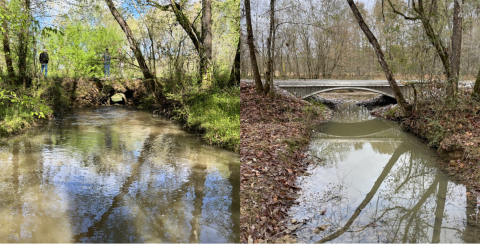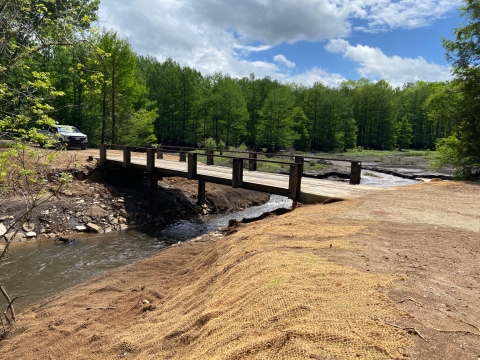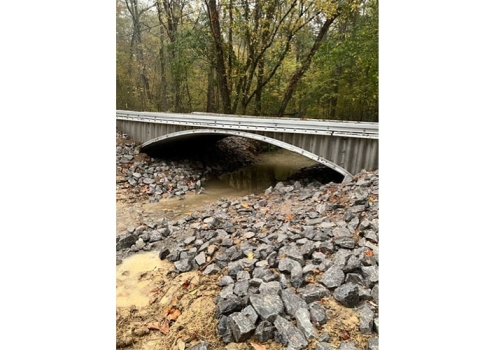Across the United States, over seven million dams and road-related barriers are fragmenting rivers, blocking fish migration, and putting communities at higher risk of flooding. While many of these structures date back hundreds of years and have been out of use for centuries, identifying these barriers can sometimes feel like finding a needle in a haystack! And with so many, how can we maximize restoration and prioritize projects? The National Aquatic Barrier Inventory & Prioritization Tool was created to address these obstacles.
The National Aquatic Barrier Inventory is a spatial database that collects and maps information about aquatic barriers (including dams, assessed road-stream crossings, and waterfalls) from local, state, regional, and national datasets. This ground-up approach creates a unique holistic combination of inventory and prioritization data, especially in areas of high conservation priority. Anyone can use the database to identify and prioritize barriers and ultimately develop projects that lead to a transformative impact across a watershed. Field staff can use the tool to verify existing knowledge and hypotheses of priority barriers, and to communicate need when justifying project selection to stakeholders. In fact, this tool has already proven successful in identifying priority projects for fish passage fish passage
Fish passage is the ability of fish or other aquatic species to move freely throughout their life to find food, reproduce, and complete their natural migration cycles. Millions of barriers to fish passage across the country are fragmenting habitat and leading to species declines. The U.S. Fish and Wildlife Service's National Fish Passage Program is working to reconnect watersheds to benefit both wildlife and people.
Learn more about fish passage and threatened species.
Breaking Down Barriers
The tool has been especially useful in helping restore habitat for threatened trispot darter and other federally listed aquatic species in Alabama. The Trispot Darter Culvert Replacement project received over $1 million in funding from the Bipartisan Infrastructure Law Bipartisan Infrastructure Law
The Bipartisan Infrastructure Law (BIL) is a once-in-a-generation investment in the nation’s infrastructure and economic competitiveness. We were directly appropriated $455 million over five years in BIL funds for programs related to the President’s America the Beautiful initiative.
Learn more about Bipartisan Infrastructure Law through the National Fish Passage Program in 2022. After identifying numerous culverts of concern, USFWS staff referenced the National Aquatic Barrier Inventory & Prioritization tool to support project site considerations. The tool assisted with the prioritization of these sites and demonstrated the watershed-scale impact of these barrier removals. This information can be shared with partners, private landowners, and other stakeholders to justify replacement and promote the benefits of such projects.
Alabama isn’t the only state where the tool is transforming watersheds. In Florida, the Sweetwater Creek Dam wasn’t listed on any inventory until it was found when compiling barrier information for the database. Following the dam’s identification, it rose to the top of the priority list within the prioritization tool output due to its high mileage upstream, species presence, and ownership type. After effective discussion and collaboration with partners and dam owners, the dam was completely removed. Not only did the tool help identify and prioritize this barrier, but it also aided in communicating the need for removal based on listed species and fish passage. The project reopened 33 miles and restored access to the Apalachicola River, vital habitat for eight species of threatened and endangered freshwater mussels.
Looking forward, the Inventory and Prioritization Tool will be used to take a watershed-based approach in identifying priority barriers to mitigate within priority watersheds. Using this approach, several entities submitted grant applications to the National Fish and Wildlife Foundation’s America the Beautiful Challenge, a funding opportunity made available from the Bipartisan Infrastructure Law. The purpose of this funding is to reconnect habitats across the Nation. In November, recipients of the 2023 award cycle were announced, which included over $14 million awarded to partners using the barrier inventory and prioritization tool to identify and implement high priority barrier mitigation projects. This includes the deconstruction of 16 priority barriers, additional assessment of road stream crossings in priority basins for important species, and compilation of existing data for National Forest Lands.
Collaboration for Conservation
The National Aquatic Barrier Inventory & Prioritization Tool started as a barrier inventory in the Southeast region by the Southeast Aquatic Resources Partnership in 2014. Since then, the tool has vastly expanded into a national inventory and soon will cover data in almost every state and U.S. territory. Inc
As data is continuously added from across the country, more states and non-profits are utilizing the tool to identify and prioritize local restoration projects. “The inventory and prioritization tool has been tremendously helpful in selecting and evaluating the ecological benefits of barrier removal and remediation projects,” said Tyler Fox of The Nature Conservancy. “It allows us to quickly get an idea of how these projects will improve aquatic connectivity in terms of stream miles reconnected and to better communicate the benefits of these AOP projects to our partners.”
As a part of its latest updates, the tool has added the ability to track cumulative miles reopened over time as well as a climate justice filter. In the future, it will expand on which species barrier removal supports and improve prioritization capabilities. As more states, non-profits, and federal agencies continue to use and implement the National Barrier Inventory and Prioritization tool, we can coordinate efforts for a holistic approach to restoration. Through identifying, prioritizing, and communicating important barrier removals, the National Aquatic Barrier Inventory & Prioritization tool is advancing watershed restoration and coordination benefits for all.






